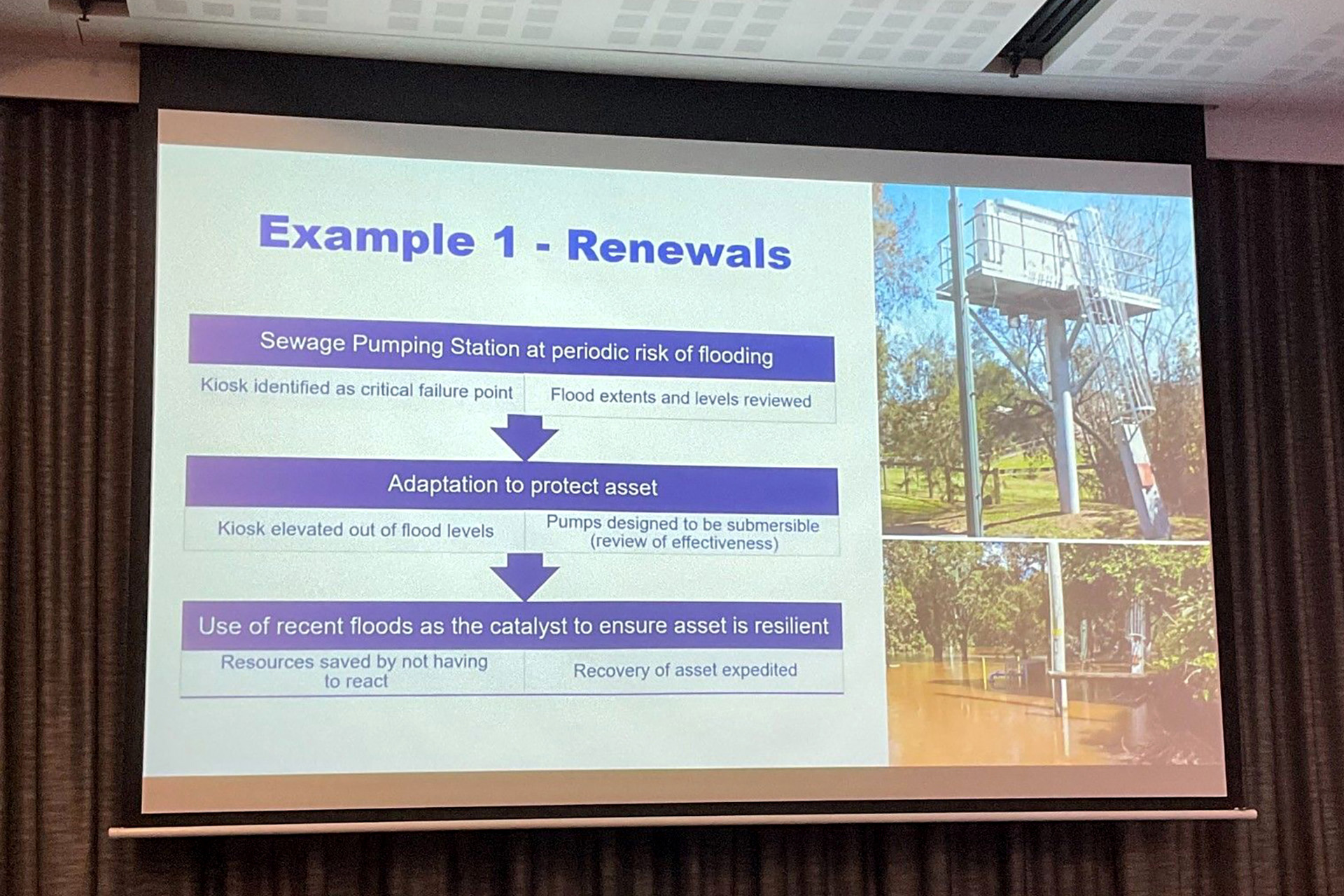Journal
Event
Early adapters
Insights and perspectives from the AdaptNSW 2022 Forum

You’ve heard that things are heating up - well, we’ve been hearing (and experiencing) that for a long time now - let’s just say things are now hot and we humans, businesses, and governments are looking at how we best adapt.
Earlier this month we attended day 2 of the AdaptNSW 2022 Forum. Safe to say, the place was buzzing with insights, ideas, and updates to do with climate preparedness + resilience. A good summary would be 400+ people who are literally getting sh*t done when it comes to climate adaptation.
It’s clear we’re now taking advantage of the new opportunities presented by changes in the climate, and with that comes a shift in the narrative around climate change as demonstrated in the updated ICCC report from Feb 2022 - Climate Change 2022: Impacts, Adaptation, and Vulnerability.
Cop27 in Egypt kicked off recently and NSW was represented by the Treasurer, Matt Kean. Jane Gibbs, (Director Climate Adaptation, NSW Office of Energy and Climate Change) spoke about the new narrative for adaptation that will be discussed at COP27, and likened it to the discussion happening locally in NSW, especially given that we have been experiencing a series of ongoing natural disasters in recent times.
To set the scene
Currently, natural disasters are costing the Australian economy $38 billion annually. This will increase to $73 billion - $94 billion by 2060 (costing in excess of $1.2 trillion).
In NSW alone, the cost will be $39 billion by 2060.
Some learnings…
1/5. 76 recommendations (fire) and 28 recommendations (floods)… ALL adopted by the NSW government
Mary O’Kane - led the Bushfire Inquiry (2020) and Flood Inquiry in (2022)
Takeaway
- NSW Government is committed and this is demonstrated by an acceptance of all recommendations.
The 2020 bushfires were the worst forest fires in recorded history. They ran from late July 2020 until the start of March 2021. They started in the south and headed north which was strange behaviour. We heard about the pyrocumulus nimbus clouds that occurred and some of the thinking behind causation. This phenomenon lead to mass spotting, black hail, and destructive lightning.
Interestingly, the recent floods were found to be within normal ranges. It was the amount of intense stationary rainfall that was alarming and different from previous rain events and this indicated a cause of climate change.
Some of the key adaptation opportunities that sit across all the recommendations included:
- Education - we need to know more about how natural disasters affect us, but also there are opportunities for integrating disaster education into the Primary School curriculum
- Better warnings and technology capability - a need for further research, robotics, sensors for remote spotting, and digital tools that are more useful for citizens
- A need for policymakers (and everyone else) to start thinking about disasters as expected phenomena - less about what the disaster is and more about how well we’re organised and prepared to respond
- Having systems in place to support secondary disasters - landslips, water contamination, smoke inhalation, and hidden impacts like mental health and financial wellbeing - a need to capture more data and deeper analysis into hidden impacts
- Improved planning - there’s a lot of pressure and work happening to reform planning for builds in flood or fire-prone areas
2/5. Applying adaptation to some sobering facts; building evidence that creates the conditions for change
Sharanjit Padam, Principal, Climate & ESG Risk, Finity Group
-
Adaptation is a very localised issue in a large complex web of systems, actors, and participants.
Finity recently authored a green paper called Home insurance affordability and socioeconomic equity in a changing climate. It’s a detailed investigation into the current state of home insurance affordability in Australia and the potential implications of climate change.
Sharanjit took us through some of the evidence that backs up what many already assume, but what this recent report does is provide the rationale needed for new thinking around adaptation for vulnerable people and communities.
The report aims to answer questions about the role that insurance plays in adaptation and resilience. How effective is it right now? How much do we rely on it, and how much does climate change affect these issues over time?
The most wicked problem that could be demonstrated through the data is that the riskiest geographies are inhabited by our most vulnerable residents with the lowest incomes. Our most vulnerable people are in the most vulnerable housing.
“It’s a classic example of why natural disasters aren’t entirely natural, through the choices we make and the way we organise the system, we create additional disasters”
-
90% of the population are paying ~1.4 weeks of annual income for their home insurance which is deemed affordable.
-
10% of the population is paying ~7 weeks of their annual income on house insurance. That equates to insurance being out of reach for one million homes.
It’s no surprise that the 10% is mostly made up of elderly, single parents, renters, low insurance literacy, and people with low savings.
We talk about global climate equity and challenges in developing nations but here in Australia, it’s clear that we’ll experience similar scenarios at a local level if adaptation isn’t applied soon.
Policy solutions need to be targeted at vulnerable communities and in an appropriate way. An example of policy gone wrong is from QLD where the government offered a co-payment for cyclone-proofing your home but as it required 25% contribution, it missed many of our most vulnerable.
3/5. Bringing together information and data for increased resilience
Kate Cotter - CEO @ Resilience Building Council of Australia (previously known as Bushfire Building Council of Australia) and Building Resilience Star Rating
Takeaway
-
De-risking our built environment creates measurable value everywhere - for banks, insurers, communities, homeowners and residents.
Kate has spent 8 years working with a broad spectrum of experts to develop a building resilience rating star system. Her organisation, Resilience Building Council of Australia, received funding to turn the rating system into a free digital resource. Attendees got a sneak peek of the product which will launch in March 2023.
It’s essentially a free self-assessment app for households that reports back a building resilience rating along with what it could be if they follow certain actions. Recommended actions are provided in order of impact on resilience, along with a cost implication so users can make decisions about where to put effort in for new and existing buildings. The pilot has shown there’s a lot that can be done, for a low cost that can significantly improve many house ratings in disaster-prone areas - increasing resilience to 3 or 4 stars.
“If we can measure it, we can treat it”
Future tools will help to inform decision-making around private investment, public investment, relocating, retrofitting, etc. Another important outcome the Council has been working on is for home insurers to offer discounts to houses that have received a certified resilience rating.
The Council has also spearheaded efforts to co-design resilient housing prototypes and blueprints for bushfire-prone areas - they’ve been using the collaboration on Fortis House to demonstrate what 5 star looks like.
4/5. An example of managing physical adaptation risk
Isabel Copemen - Resilience and Change Adaptation Lead, Sydney Water
-
Bold measures are being taken to change the way things have historically been done to be way more pragmatic and adaptive to our predicted future.
Isobel reminded us how often that day we’d already interacted with services delivered by Sydney Water (shower, toilet, breakfast, tea, brush teeth, water plants, coffee, fill water bottle…) - at least 20 times and it was only 11am!
Asset management is a fundamental part of climate adaptation. Let’s call it physical risk, but it’s not their only risk. From an adaptation perspective - they’re also needing to plan for climate risk to the product (water quality), and they need to think about broader system risks and ensure they can provide services throughout a disaster.
They’ve taken the bold approach and now manage the physical risk of assets that assumes future scenarios - that being a predicted temperature or anticipated rain for a future state. This is a different approach from traditional asset management procedures which is to do a risk assessment based on historical data.
Isobel gave the practical example of an adaptive pathway for an existing asset which is a small sewerage pumping station on the Nepean river where they’ve raised the electrics to be safe in a 1 in 100 flood.
Climate-resilient assets are now the standard for building new infrastructure.

5/5. Supporting adaptation opportunities to reduce food production risk
Dr Sue Ogilvy – Program Director, Farming For the Future
-
Activating and building awareness around natural capital is critical to help farms be more regenerative and resilient to future climate.
Natural capital is a term that we’re hearing more about, and Dr Sue Ogilvy helped to demystify exactly what it is, and what role it can play in helping the agriculture sector to adapt and be better prepared to protect food production systems.
Natural capital is all of the biological and ecological assets on a farm - for example, soil and vegetation. It enables free inputs to the farm business, it’s a better storage of carbon and biodiversity, and it’s more or less resilient to climate change.
To put this into perspective, natural capital is everything that is invisible on a farm.
Farming for the Future is figuring out how to build adaptive capacity for farmers. For example, research has shown that when farmers invest in a good diversity of native grasses, pastures become a lot more resilient and dependable, and animals do better because they have more diversity in their diet. Investing in shade or natural shelter provides protection from bad weather events. Advances in cropping technology and strategies improve the biodiversity of soil which improves performance during weather events. Farmers that focus efforts on their natural capital come into drought later and out of drought earlier which of course impacts food production.
There is a lot of awareness building around natural capital and it’s aimed at making its value visible, as currently, natural capital doesn’t contribute to the asset value.
Natural capital should be of high interest to government and private sector because if there’s a clear relationship between natural capital and farm profitability - this could inform many things such as when government should invest in natural capital or maybe it’s about knowledge and skills for farmers.
This unlocks a whole lot of public good for farmers and society. Farming for the future is running further studies at the moment to develop more data over the next couple of years (apply here) which they hope will be transferred into the public good as a form of nationally significant information infrastructure.
To wrap...
Adapt 2030 conference was a win. 85 presenters (64% of them women), 29 sessions, 46 presentations, and zero waste. We’ll take the insights and new perspectives into our own strategic design practice and look for ways we can take an adaptive approach to our own footprint.